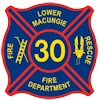Fires can occur when you least expect it, leaving little time to plan your escape, so the time to prepare for an emergency isn’t when your alarm sounds. According to the National Fire Protection Association (NFPA), only 32% of American households have actually developed and practiced an emergency escape plan. Make time to sit down with your family to plan and practice what you would do in case of a fire or carbon monoxide (CO) emergency. Consider the following tips when helping to prepare yourself and your loved ones:
1. Map it out. Begin thinking about a home fire escape plan by first drawing a map of your home, making sure to label each window and door. Identify two ways out of each room and walk through your home to make sure the doors and windows you’ve chosen as exits open easily. If your family’s home has a second floor, consider having escape ladders in each room. You can find templates online to help you get started.
2. Choose a meeting spot. After you have mapped out all of the ways you can exit, pick an outside meeting spot a safe distance away from your home, such as across the street, at a mailbox or in front of the neighbor’s home. Be sure that your family knows that once they are outside, they need to call 911 and stay outside. Additionally, explain it is important that everyone knows never to re-enter the home for any reason and to let a firefighter know if someone is missing.
3. Help your loved ones. Assign someone in your family who can assist infants, seniors or pets during a fire. The responsible person should be in good health and be able to provide the assistance needed.
4. Check your smoke alarms. Having working smoke alarms on each level of the home and in every sleeping area is key to having a safe home. Check that you have alarms properly installed throughout your home and remember to test all of the alarms regularly and replace them at least every 10 years. If you have children, consider installing a First Alert Smoke and Carbon Monoxide Alarm with voice and location technology throughout your home, and especially in their bedroom. This alarm will notify your child of an emergency, distinguishing between a fire or carbon monoxide incident, in a human voice as opposed to a regular alarm. This is especially helpful if a fire strikes at night. Studies have shown children may have an easier time waking up to the sound of a human voice rather than an alarm.
“Smoke alarms are designed to give early warning in case of fire, and making sure your home has properly installed and maintained alarms is the best defense against one,” said Tarsila Wey, director of marketing for First Alert. “As far as CO is concerned, the only way to detect this fatal gas is with a CO alarm, so have one installed on each level of the home and near every sleeping area.”
5. Plan. Practice. Repeat. Once your escape plan is finalized, your job is not done. Gather your family together and put your plan in action. Practice this plan at least twice a year, so if disaster strikes, your family will feel confident in their ability to exit the home safely. To make the drills as realistic as possible, conduct them both during the day and at night.
“Planning ahead can save a life,” added Wey. “Talk with your family to make a plan that fits all of your needs.”
For more information about escape planning and fire safety tools, visit www.firstalert.com.
